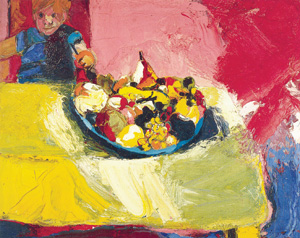

BAY AREA Beat artist Jay DeFeo worked on her masterpiece, The Rose, for eight years, restlessly applying layer after layer of viscous oil paint, finally achieving a large starburst abstraction that is as much sculpture as it is painting. In some spots, the pigment rises in ridges, like a mountain range, to a thickness of more than 8 inches. According to historian Martha Sherrill, when the painting was restored, conservators “discovered that the thicker areas of paint were quite soft. … The Rose had never entirely dried, and wouldn’t for a hundred years.”
The Rose represents perhaps the apotheosis of the technique known as impasto. DeFeo, who attended high school in San Jose and took an art class at San Jose State, serves as an unnamed muse for “Juicy Paint,” the new show at the San Jose Museum of Art drawn from the permanent collection.
The exhibit features a wide selection of artists who revel in the sensuous physicality of paint (primarily oils). It is not a criticism to note that these painters take the same pleasure in brushing, scraping and manipulating thick gouts of paint as children do with their finger paints.
In Twist (1999), Phe Ruiz, who attended UC–Santa Cruz, applies paint in ultraglobby mounds that are still redolent of turpentine if you lean in closely enough. This large abstraction features passages of roiling red rising from a primordial blackness. A mushrooming burst of blue in the upper left begs to be read as a serene sky presiding over chaotic creation.
Sam Tchakalian’s Home in One (1990), a large, horizontally striated field painting, contrasts dry brush strokes with heavier, wetter application of blue and light brown hues, all gently vibrating against an overall wash of turquoise. Also drawing on the energy of pure color and sweeping brush action, James Kelly’s Evolution bursts with surging broad swatches of red mingled with distorted rectangles of white and yellow. It’s as if the artist’s inner storm had set the canvas on fire.
The act of piling up pigment tends to overwhelm the illusionism of narrative and figurative painting, but Joan Brown manages to have her abstraction and eat it too with Noel at the Table With a Large Bowl of Fruit (1963). The sumptuous blobby fruits are barely outlined enough to make out some grapes and a protruding pear, but mostly the brush strokes swirl and flow together, barely suggesting physical objects. Instead of a rigid table, the bowl sits on an expanse of heavily brushed yellows, whites and olives. A small boy, his pinkish face echoed by a backdrop of flesh tones, reaches for permitted fruit.
Using acrylics and enamels instead of oil, Sam Gilliam goes the furthest on the spectrum from 2-D painting with layers to flat-out sculpture. Deep Pool, Deep Blue Reflections (1987) isn’t just painted, it is encrusted with squishy smears of bright, shiny colors that stick out with the insouciance of cake frosting. Not content to stop there, Gilliam added some curvilinear and zigzag pieces of metal. Is it a painting with sculptural overtones or a painted sculpture? The piece is wittily supplemented with a display of the rubber boots Gilliam wore while creating Deep Pool; they are bespattered so thickly it’s as if the artist had used them to wade through a neon tar pit.
The most compelling piece is Dante (1962) by Karl Kasten, a product of the fertile San Francisco school of abstract expressionism and still going strong at 93. Dante‘s dramatic interplay of red, dark green and violet shapes is set in an inky whirl of midnight-blackness. Oozing lines of paint that look squeezed directly from the tube alternate with dry, scraped areas. An intense jagged splurge of yellow gives the painting an internal light source. It is a masterful painting that commands your eye up close and from across the gallery.
JUICY PAINT runs through June 6 at the San Jose Museum of Art, 110 S. Market St., San Jose. (408.271.6840)


